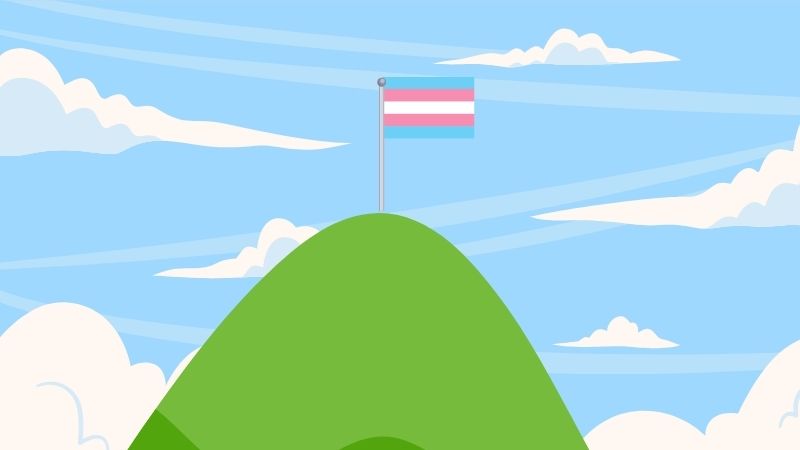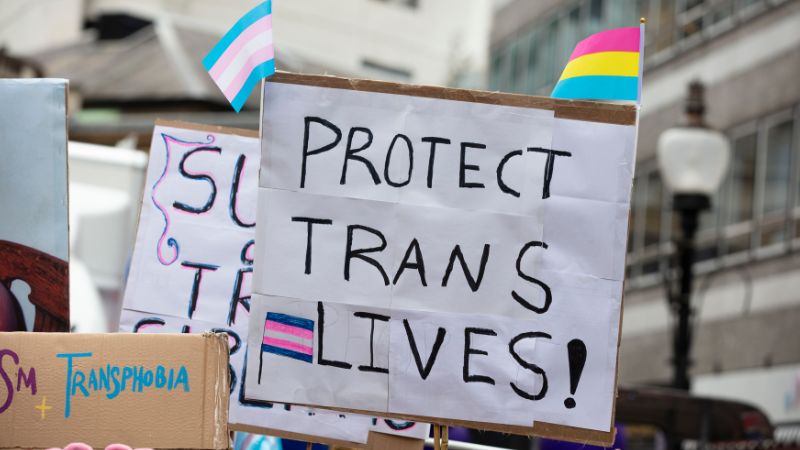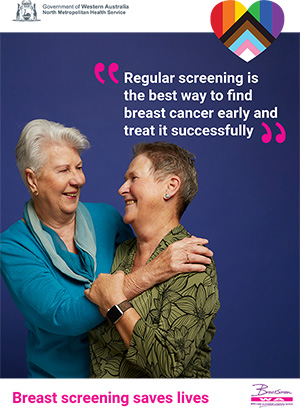OPINION
Lyn Hardy is a trans woman living in Perth on Noongar Whadjuk country. She is a scientist who is a passionate advocate for transgender rights, health care, and inclusion.
Nearly 6 months ago I wrote a letter that I sent in to OUTinPerth that was not published, but in it I expressed the fear that trans folk are feeling in the world. This was at a time when Trump was starting his attacks on trans folk. Sadly, the lives for trans folk in the USA has only gotten harder since then.
Over the last few years, starting with the release of the Cass Review was released, and then followed by ‘guidance’ from the poorly named ‘Equality and Human Rights Commission’ in the UK, the lives of transgender folk, young and old, have been threatened with such disruption that an overwhelming majority of trans people feel unsafe in UK according to a YouGov Poll reported in Pink News.

Even here in Australia we have felt the effects of the Cass Review, with the Queensland Liberal government following the boot prints of the Brits and halting medical transition for transgender teenagers in that state.
And only hours after a supreme court ruling saying that process that the Queensland government took was unlawful and that the ban should be lifted, the ban was reinstituted by the Queensland health minister. The Australian government has, on the back of the Cass Review, ordered the National Health and Medical Research Council to develop a new national guideline into the medical care of trans and gender diverse people under the age of 18; although this is a more positive step than the Cass Review.
At the time of writing this, the transgender community is again reeling from an assault. This time from within the LGBTQIA+ community, showing the division that exists between a number of the L and the G with the T. An opinion piece by Carl Gopalkrishnan published in OUTinPErth on 31st October highlights the broader issues with the now removed podcast from The Equality Project.
It is worth noting that the issues raised by Carl regarding the method of attack used in the podcast are issues that the trans community has been trying to call notice to since the anti-transgender hate group ‘the LGB Alliance’ was formed in the UK in 2019. Sadly, they have had success in the UK, and the voices of trans folk have been lost from discussions.
There is a problem that the cisgender members of the LGBTQIA+ community need to address, and that is transphobia.
The opinion piece by Carl didn’t go into detail about the podcast in question. I will, because the podcast implicitly stated that the full inclusion of trans folk in society was not a hill worth dying on. To quote from the podcast:
Matt Beard (@ 14m 01s): “So I think we need to find the courage to admit where we went wrong. And I think a big part of that is choosing the right hills to die on. I think we moved over the last 10 years or so from winning campaigns in which our liberation didn’t plausibly impede the rights of anyone else. And I’m thinking of campaigns like marriage equality and anti-discrimination legislation. So we’ve moved from those kind of campaigns, which we won, to actually losing campaigns in which our opponents can plausibly claim a clash of rights.”
Well, that hill is the one that trans folk have no choice but to die on.
The podcast touched specifically on three issues:
- Inclusion of transgender women in society
- Self-identification for transgender individuals
- Transition for transgender children
I will provide some quotes from the podcast:
Matt Beard (@ 19m 04s): “That there are biological differences between males and females in terms of sport performance that have now been pretty much unequivocally proven across most sports.”
This is a major problem, because gender affirming hormone therapy (GAHT) changes large amounts of physiological properties for transgender people. For transgender women, who are the only party targeted (for some reason that has nothing to do with science), the physiological changes are quite starks: Increase in fat mass, decrease in muscle mass, not to mention that worse lung function and breathing efficiency, and haemoglobin levels also drop to similar levels as what cisgender women have.

Studies have shown that after 2 years of GAHT, trans women have no advantage over cis women, and after 4 years of GAHT, there was only a statistical advantage in push-ups… So while Matt says that there are “biological differences between males and females”, physiologically trans women on GAHT are more like cis women than cis men.
He goes on to say (my emphasis in bold): “And again, I wonder whether a more open ability to have those discussions around how we create fairness in sport through additional categories through a more nuanced approach to the type of sport and how trans people, particularly trans women, can be included would have been better than a blanket set of campaign objectives that said, whatever the sport, if someone identifies as a trans woman, they should be included in the female category.”
This is confusing the idea of self-identification with the requirements to meet the necessary standards at elite sporting levels. Trans women who don’t take GAHT would have male levels of testosterone, while transwomen who DO take GAHT have testosterone levels equal to or lower than cisgender women. So no, Mr Beard, there is no reason to have separate categories for trans women. Just look at the number of trans women who competed in the Olympics and won a medal…
The exclusion of trans women from sport has nothing to do with science. And on the safety front, there’s no evidence for increased injury risk for cisgender women competing against transgender women; a Google search only shows hyperbole and no studies.
Legal self-identification as an issue is a theme throughout the podcast:
Matt Beard (@ 17m 02s): “But the rapid move to full self-identification without bringing in women’s movements into those discussions, without having those conversations about the potential clash of human rights that that represents means that a very defensive stance has been taken by many women’s movements who make the claim, sometimes reasonably framed and sometimes framed in a deeply transphobic way, that trans women who have self ID’d coming into women’s spaces represents a risk certainly to the comfort of women and sometimes potentially to the safety of women.
The claim made by our opponents that we haven’t properly tackled is that this violates one of the basic principles of safeguarding. The safeguarding is based on the idea that, of course, not all males are potential sex offenders, but because some are, that is why safeguards are in place to prevent males being in female-only spaces.”
The biggest problem with this is it automatically associates trans women with potential sex offenders as well as males. When have cisgender male sex offenders ever needed to pretend to be trans women in order to access a female-only space to sexually assault a cis woman? Cis male sex offenders will violate a female-only space to sexually assault a woman without going through the process of signing an affidavit in front of a Justice of the Peace… The safeguards are already in place!
Jason Tuazon-McCheyne (@ 29m 56s): “In recent decades, we’ve had some really big wins across the globe for LGBT plus rights, but it was never at the expense of, it didn’t feel like it was at the expense of other people.”
So the inclusion of trans folk comes at the expense of other people? Both Jason and Matt make a mistake that is at the heart of the problem. They both still think of transgender women as men. They look at transgender women as invading female spaces because they were assigned male at birth. Sex assigned at birth is based off the appearance of the genitals.
As I’m sure both Jason and Matt are aware, genitals do not determine sexuality… Genitals also do not determine identity. Intersex people know this very well, and as shown in some very tragic cases where people were deliberately assigned to opposite sex, they don’t work out very well…
The case of David Reimer is very pertinent. He was assigned male at birth but had a botched circumcision, so the decision was made to remove his penis and testes and raise him as a girl. It failed. When he reached puberty, he started undergoing what is now known as gender dysphoria and subsequently reverted to his birth sex. You can’t put someone into a box that they are not. In the case of trans folk, they just were never what the genitals suggested they were.
Once you accept trans women as women, then it becomes a moot point. And I say this as a trans woman who has had far more acceptance from cis women than from cis men. Even early in transition, I had a cis woman unknown to me defend me in public when my identity was questioned whilst on public transport.
My first summer post-op from vaginoplasty, I was at a public swimming pool with my kids at swimming lessons and I had a Muslim lady strike a conversation with me whilst waiting for the lesson to end – something I’m certain that she would never have done if she thought I was a man, as I was wearing a bikini at the time! The problem here is not cis women or trans women…
Matt Beard (@ 38m 01s): “I would love us as societies, as our movement, to celebrate a young boy who wants to wear a dress, who wants to play with pink toys, who wants to do the things that are stereotypically deemed by our society to be feminine, and to celebrate his gender nonconformity without necessarily, and I use the word necessarily, very deliberately, without necessarily having the need for that child to transition.”
And this is something that does not happen. Transition only happens if the child is diagnosed with gender dysphoria and wants to transition, and the child’s parents allow it! The view that Beard takes is totally against the affirmative care model. Affirmative care doesn’t mean forcing transition on children, which is the narrative that people aligned with the gender critical movement push; affirmative care means supporting the child, not being an asshole.
Matt Beard (@ 39m 13s): “I want to say once again that I completely acknowledge that gender dysphoria is real and that some children are experiencing it and need to transition. But I also think that we need to be careful with that and that we also need to celebrate some children who just don’t conform to the stereotypical gender roles.”
And right there is a problem. I’ll paraphrase: “Gender dysphoria is real, but we can’t trust children to known themselves so we should just let them explore but not transition.” So, Matt, when did you know you were gay? Was it before the age of 18? Was it in puberty, when you weren’t attracted to girls that same way that your straight friends were?
All transgender adults started as transgender children. Many might not have realised, or been able to do anything about it, until they were adults, but they were all children first. Many of my age group and older had it beaten out of them as children, or were subjected to conversion therapy to ‘fix’ something that was perceived to be broken. Understanding has moved on, and being transgender is now understood to be an innate characteristic.
This is the reason why the affirmative care model was arrived at after years of trial and error – if there’s nothing broken in the person, you can’t fix them by forcing them to be something that they are not; the only option left is to support them.
Matt Beard (@ 35m 59s): “And then we move into the extremely controversial area of puberty blockers, which is the hormonal interventions that I was talking about, and potentially in extreme cases, even surgical interventions.”
It’s funny how puberty blockers are only controversial for transgender children and not cisgender children… This once again comes down to the denial of agency to teenage children, and the mistaken belief that they are easily prescribed. I would really recommend reading this.
The recommended practice for prescribing puberty blockers under the Standards of Care issued by the Royal Children’s Hospital in Melbourne, which is the model most widely used in Australia pending the NHMRC review, is (bold emphasis mine):
- A diagnosis of Gender Dysphoria in Adolescence, made by a mental health clinician with expertise in child and adolescent development, psychopathology and experience with children and adolescents with gender dysphoria.
- Medical assessment including fertility preservation counselling has been completed by a general practitioner, paediatrician, adolescent physician or endocrinologist.
- Tanner stage 2 pubertal status has been achieved.
- The treating team should agree that the commencement of puberty suppression is in the best interest of the adolescent and assent from the adolescent and informed consent from their legal guardians has been obtained.
The initiation of puberty blockers is not a simple process. Given that the complete ban in Queensland followed a single instance where the rules were not followed in one clinic, and that according to The Guardian there were 491 patients who were prevented from starting blockers and nearly 600 allowed to continue on with their treatment, the ban seems to be complete overreach for a single failure at a single clinic. It shows that the decision was never based on clinical practice across the state and was completely political in nature. Sadly, the lives of trans people are now political.
Is more study needed? Absolutely!
Is preventing people from accessing them going to help? Not at all.
In the UK after the Cass Review was handed down and the use of puberty blockers was banned unless under clinical trial, there have been a grand total of 0 clinical trials initiated. The only trial to even be announced is still awaiting ethical approval. The decision to restrict healthcare for transgender youth and the massive delays incurred in the NHS is completely political and has already resulted in death.
This podcast projects views that align with gender critical thinking and are presented without any counter by two cis gay men. I know that there are a lot of cis gay men who support trans folk; I call upon you to speak some sense to the ones that don’t. Same to our cis lesbian cohort out there – support your trans sisters.
One of the biggest questions that the podcast raises is how a rational discussion can be held between people who hold gender critical beliefs and transgender people and their supporters. In order to hold a rational discussion, there has to be a base on which to lay the foundation. But where do you begin when one party denies the validity of the other party, let alone anything that comes after?
So yes, we do have to choose the hills that we die on. But for transgender people, we are that hill. We don’t have anywhere else to go but back into the closet or into an early grave. We ask for cisgender supporters to stand with us and not just wave flags from the sidelines, but we don’t have a choice about which hill we stand on.
Lyn Hardy






